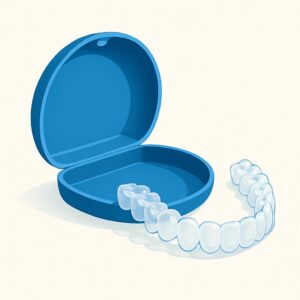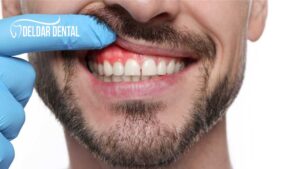More and more people are experiencing jaw pain, migraines, facial pain, ear ringing, and ear pain. What is the cause? In most cases, the pain is related to TMJD, or temporomandibular joint disorder. Basically, this is a disorder of the jaw joint, right where the upper and lower jaws meet. When there is an issue with the joint, it can cause an extraordinary amount of pain.
Many people search for a Carmel, Noblesville, and Indianapolis dentist who is also a TMJ dentist so that they can find some pain relief. We completely understand how overwhelming such pain can be. That is why we explain to our patients what they can do to treat the pain and what they can do to prevent TMJ pain.
TMD Treatments and 5 Exercises That Can Help Relieve TMJ Pain
When it comes to TMJ pain relief, there are many options. We’ve found that, in some cases, the issue has been resolved with:
- Braces: When a patient’s teeth and jaw don’t fit perfectly, it can put a lot of pressure on the jaw joint. Getting the teeth to align properly through the use of braces can remedy this issue.
- Bite Adjustment: For some people, braces might be contraindicated. Their bite may only be slightly off. So, instead of putting them through orthodontia, it may be easier to adjust their bite. This is done by checking the bite with articulating paper—a thin, strip of carbon-like paper that marks where the teeth touch each other. Any spots that are too high are “sanded down” to make the teeth fit together better.
- Splint or Night Guard: Molds are taken of the patient’s teeth and a mouth guard is fabricated using them. The patient may be told to wear the splint 24/7 or just at night. In some situations, the patient may be told to wear the splint 24/7 for a year and then only nightly thereafter. The splint protects the teeth and jaw joint by providing a smooth surface for the teeth to glide on during the night. This is when clenching and grinding occur most often.
Another option for patients dealing with jaw pain is to do at-home exercises on a daily basis. Most TMJ patients clench their teeth, causing the face and jaw muscles to tighten. This is often what causes the facial pain, ear pain, and even ear ringing. There are five TMJ exercises patients can perform at home to help relax the muscles and reduce the pain. According to Colgate, these exercises fall into three categories: strengthening, relaxing, and stretching.
5 TMJ Exercises That Can Help Relieve TMJ Pain by TMJ Carmel & Noblesville Dentist
1. Relaxation Reduces and Prevents Pain
Relaxation is vital to reducing TMJ pain. We highly recommend checking in with yourself multiple times per day to see how relaxed or tight your jaw muscles are in that moment. If you notice that your jaw is tight, take a moment to do some deep breathing. Focus in on your shoulder, neck, jaw, head, and facial muscles. Mentally tell your muscles to relax. Focus on one muscle group at a time. Don’t move on to another group until the ones you’ve been working on start to relax.
2. Side-to-Side Stretching
We recommend doing stretching exercises only when your jaw is already relaxed. Trying to stretch muscles without first relaxing can strain them and make the pain worse. Once the muscles are relaxed, keep your mouth closed but slide your jaw to the left. Looking to the right while doing this will help you deepen the stretch. Hold this for a few seconds. Then, slide your jaw to the right side and look to the left.
3. Up-and-Down Stretching
With the jaw muscles relaxed, gently open your mouth as wide as possible. Do not try to open it beyond your comfort level. Keep open for a few seconds, then gently close. Repeat a few times throughout the day.
4. Resisted Closing and Opening Exercises
Resistance exercises are used to strengthen the jaw muscles. They should not be done if the patient is experiencing a lot of pain. Doing these exercises in this kind of condition will only exacerbate the problem.
Put your thumbs under your jaw and press up gently. Slowly open your mouth while using the resistance of your thumbs. Repeat a couple of times.
5. Side-to-Side Resistance
This exercise is similar to the side-to-side stretching exercise we recommended above. This time, place the palm of your hand against your jaw and push against it gently. Repeat on the other side. Again, do not do this if you’re currently experiencing pain.
How to Avoid Jaw Pain: The Dos and Don’ts of TMJ Care
Besides doing TMJ exercises, many of our patients wonder what they can do to avoid pain in the first place. Patients with TMJ pain should avoid the following:
- Hard, crunchy foods like carrots, particularly when the jaw muscles are already tired or in pain.
- Chewing gum. This exhausts the jaw and mimics clenching, which is a major cause of jaw pain.
- Slouching, bad posture, using non-ergonomic phones, chairs, and computer keyboards.
Relief for TMJ Pain: How Your Noblesville Dentist Can Help
At Deldar Dental, we want to help all of our patients dealing with TMJ pain, migraines, facial pain, and ear pain find relief fast. Part of this lies in at-home TMJ exercises and doing your best to prevent pain in the first place. Another important part of the pain relief equation is your Noblesville dentist.
A TMJ dentist can provide you with a comprehensive treatment plan that focuses on pain relief. This treatment plan may include more TMJ exercises, a splint or night guard, braces, or even surgery. The most important thing to remember is that you are not doomed to pain. Your Noblesville dentist can help you find pain relief options that work best for you!
Do you experience jaw pain or migraines on a regular basis? Have you tried at-home TMJ exercises but still experience pain? If so, please contact us today. We can provide you with even more options so you can finally get some relief from pain.




